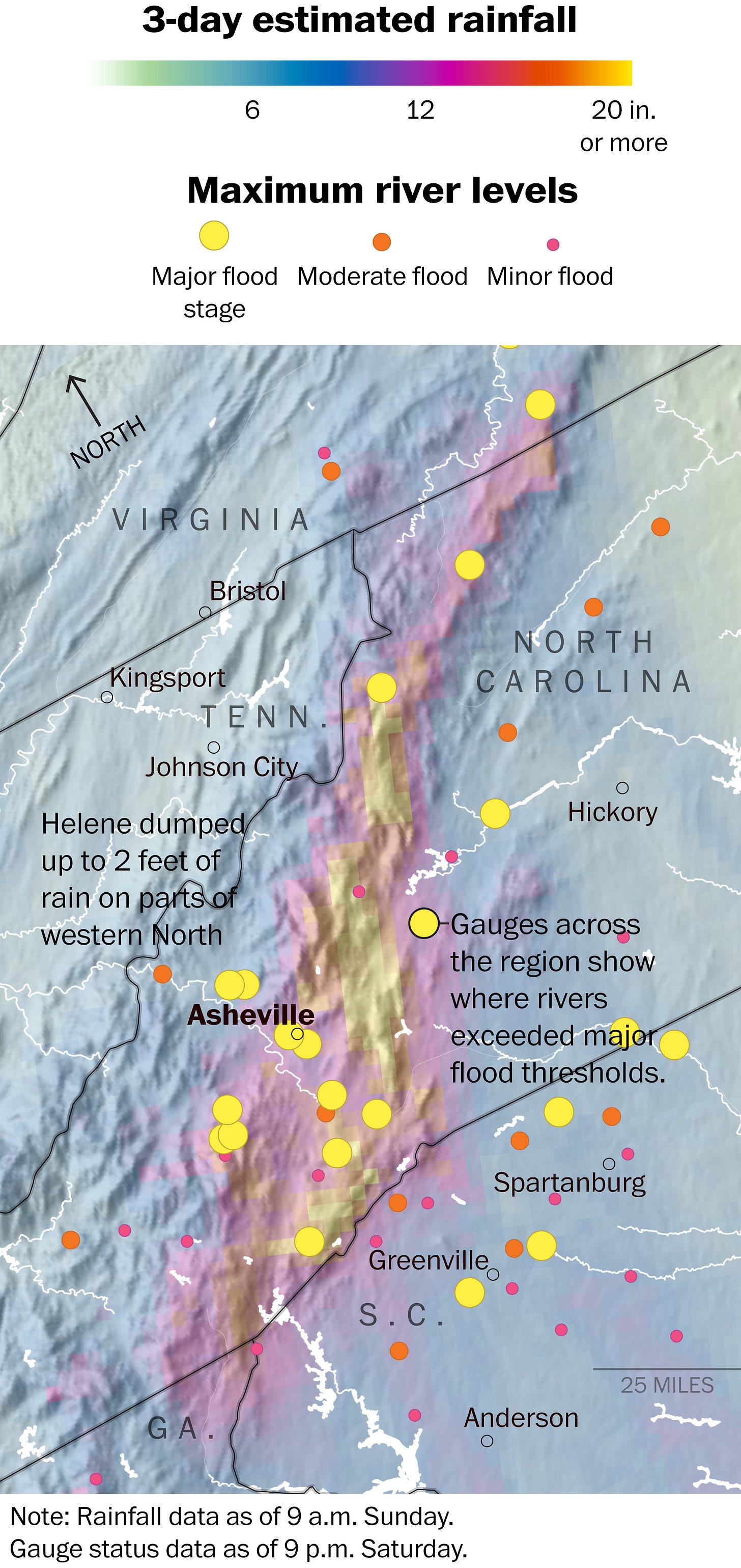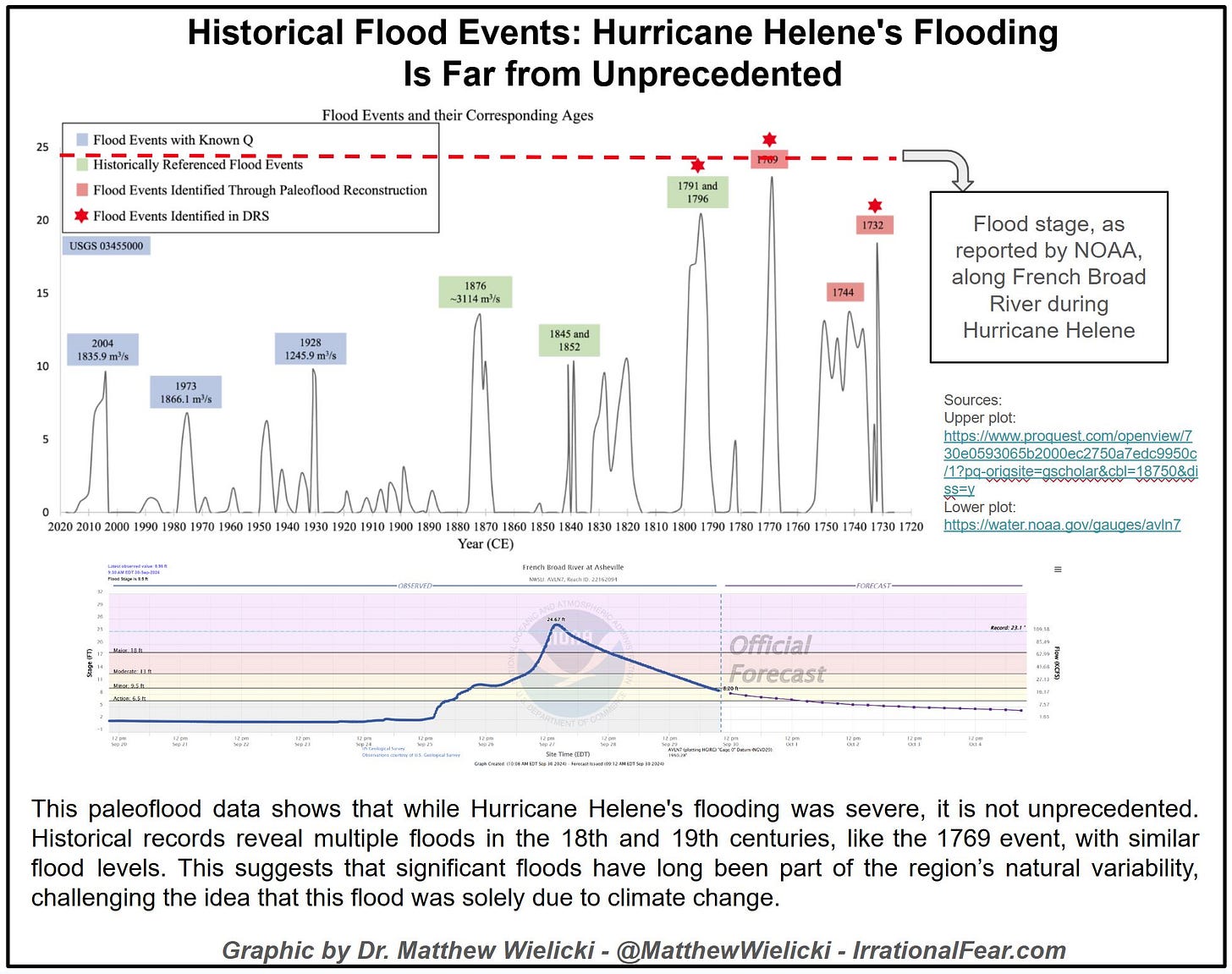“Storms Don’t Care About Politics: Floods, Politics, and the Farce of “Climate Resilience” Rankings”, By DR. MATTHEW WIELICKI
“The rankings emphasize metrics like education, infrastructure spending, and life expectancy, factors that disproportionately benefit urban, Democrat-leaning areas.”
Irrational Fear
29
Storms Don’t Care About Politics
Floods, Politics, and the Farce of “Climate Resilience” Rankings
NOV 26, 2024
∙ PAID
When Hurricane Helene dumped up to two feet of rain across the Carolinas in September 2024, it left thousands of residents grappling with destruction, evacuation, and uncertainty. Streets in Asheville turned into rivers, homes were submerged, and entire neighborhoods faced devastation. But according to the Washington Post’s climate resilience rankings, Buncombe County, home to Asheville, was supposedly well-prepared to handle such disasters. Neighboring counties, however, were deemed less resilient, even as they endured similar impacts.
Subscribed
This disconnect between on-the-ground realities and resilience rankings raises a troubling question: Are these rankings about helping communities prepare for disasters, or are they merely political posturing disguised as science?
Resilience Rankings vs. Reality in Buncombe County
The Post’s resilience map paints Buncombe County in a favorable light, touting its ability to “rebound from adversity.” The rankings emphasize metrics like education, infrastructure spending, and life expectancy, factors that disproportionately benefit urban, Democrat-leaning areas. Yet, when Hurricane Helene struck, Buncombe County’s supposed resilience was nowhere to be found.

During the storm, Buncombe County experienced catastrophic flooding, with rivers matching major historical flood thresholds (see graphic below). In just three days, the area received up to two feet of rain, overwhelming infrastructure and forcing evacuations. The rainfall map below illustrates the intensity of the storm, which inundated urban and rural areas alike.

This wasn’t a new phenomenon for Buncombe County. Asheville has a long history of devastating floods dating back to the 18th century. Geography, not governance, is the driving factor. Steep slopes and rapid runoff make the region inherently vulnerable, a reality no amount of political spin can erase.
Neighboring Counties: Equally Wet, Less Resilient?
While Buncombe County struggled, its neighbors, like Henderson and McDowell counties, faced similar flooding risks. However, these rural, Republican-leaning areas received far lower resilience scores from the Post. Why? The rankings penalize counties for lacking urban infrastructure and higher incomes, even though these communities often employ practical, cost-effective measures to mitigate disaster risks.
Take Greenville County, South Carolina, as another example. Despite scoring lower in resilience, it faced outcomes comparable to Buncombe during Hurricane Helene. Similarly, Spartanburg County endured moderate to major flooding but, due to its rural makeup, was categorized as less resilient. The vulnerability map below highlights these discrepancies, painting rural counties in orange while urban areas like Asheville are labeled resilient.

This underscores a central flaw:
Subscribed
Resilience rankings don’t measure actual preparedness or outcomes, they measure socioeconomic status and urbanity. The bias embedded in these metrics dismisses the efforts of rural communities while overstating the readiness of urban centers.
The Political Geography of Resilience Rankings
Adding to the controversy is the striking correlation between resilience scores and political leanings. In North Carolina, counties that voted Democrat, like Buncombe, are praised for their resilience. Counties that voted Republican, meanwhile, are labeled more vulnerable. The map of the 2024 presidential election results (below) underscores this troubling overlap.

This alignment isn’t coincidental. The rankings equate resilience with urban, progressive policies while dismissing the strengths of rural governance. By framing resilience as a partisan issue, the Post reinforces stereotypes about rural incompetence and urban superiority. Yet, when disaster strikes, both areas face similar challenges and similar failures.
Ignoring Historical and Geographic Realities
Perhaps the most glaring flaw in the resilience rankings is their failure to account for geography and historical vulnerability. Buncombe County’s risks aren’t new, they’re intrinsic. Nestled in the Appalachian Mountains, the region is prone to flooding due to its topography. Similarly, other parts of western North Carolina and South Carolina face recurring risks tied to steep terrain, dense vegetation, and rapid water runoff.
These geographic realities are immutable. No amount of infrastructure spending or progressive governance can eliminate the fundamental risks posed by terrain. Yet, resilience rankings downplay these factors, creating a skewed framework where urbanized areas are celebrated for resilience, even as they experience the same, or worse, disaster outcomes as rural regions.
A Call for Real Resilience
If Hurricane Helene taught us anything, it’s that nature doesn’t care about politics, or resilience rankings. Floodwaters don’t respect county lines, party affiliations, or socioeconomic metrics. True resilience isn’t about scoring well on a politically motivated map, it’s about practical preparation, adaptive infrastructure, and community-driven solutions.
To build real resilience, we must abandon these partisan frameworks and focus on evidence-based strategies, such as:
Investing in Flood Defenses: Reinforcing levees, upgrading stormwater systems, and restoring natural floodplains.
Zoning for Risk Reduction: Preventing risky developments in flood-prone areas, regardless of political pressures.
Prioritizing Local Adaptation: Empowering rural communities with the resources to implement their own disaster-mitigation strategies, such as watershed management and community-led response plans.
Resilience cannot be measured by political affiliation or urban demographics. It must be earned through practical action, historical understanding, and the recognition that geography plays a critical role in shaping vulnerability.
When the next storm comes, it won’t be resilience rankings that save lives, it will be real preparation, cooperation, and adaptation.







Spending a Career fixing what the experts with $$ screwed up, but could not fix. Always require innovation & community collaboration & out thinking closedminesto change. To do what their $ $ boys always said . Not my problem. There is no solution. As we blow the budget applying 20thcentury horse& buggy silo vision to get a Nortel ending. Only to realize to late . If they had worked with their employee. They would not have just sold off a diamond in the rough but no clue what they were looking at.